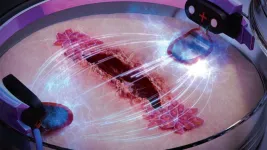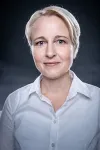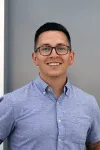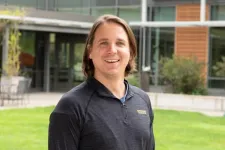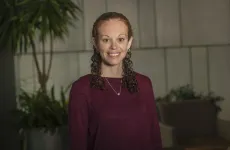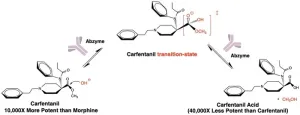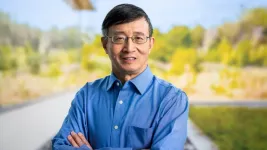(Press-News.org) Chronic wounds are a major health problem for diabetic patients and the elderly – in extreme cases they can even lead to amputation. Using electric stimulation, researchers in a project at Chalmers University of Technology, Sweden, and the University of Freiburg, Germany, have developed a method that speeds up the healing process, making wounds heal three times faster.
There is an old Swedish saying that one should never neglect a small wound or a friend in need. For most people, a small wound does not lead to any serious complications, but many common diagnoses make wound healing far more difficult. People with diabetes, spinal injuries or poor blood circulation have impaired wound healing ability. This means a greater risk of infection and chronic wounds – which in the long run can lead to such serious consequences as amputation.
Now a group of researchers at Chalmers and the University of Freiburg have developed a method using electric stimulation to speed up the healing process.
“Chronic wounds are a huge societal problem that we don’t hear a lot about. Our discovery of a method that may heal wounds up to three times faster can be a game changer for diabetic and elderly people, among others, who often suffer greatly from wounds that won’t heal,” says Maria Asplund, Associate Professor of Bioelectronics at Chalmers University of Technology and head of research on the project.
Electric guidance of cells for faster healing
The researchers worked from an old hypothesis that electric stimulation of damaged skin can be used to heal wounds. The idea is that skin cells are electrotactic, which means that they directionally ‘migrate’ in electric fields. This means that if an electric field is placed in a petri dish with skin cells, the cells stop moving randomly and start moving in the same direction. The researchers investigated how this principle can be used to electrically guide the cells in order to make wounds heal faster. Using a tiny engineered chip, the researchers were able to compare wound healing in artificial skin, stimulating one wound with electricity and letting one heal without electricity. The differences were striking.
“We were able to show that the old hypothesis about electric stimulation can be used to make wounds heal significantly faster. In order to study exactly how this works for wounds, we developed a kind of biochip on which we cultured skin cells, which we then made tiny wounds in. Then we stimulated one wound with an electric field, which clearly led to it healing three times as fast as the wound that healed without electric stimulation,” Maria Asplund says.
Hope for diabetes patients
In the study, the researchers also focused on wound healing in connection with diabetes, a growing health problem worldwide. One in 11 adults today has some form of diabetes according to the World Health Organization (WHO) and the International Diabetes Federation.
“We’ve looked at diabetes models of wounds and investigated whether our method could be effective even in those cases. We saw that when we mimic diabetes in the cells, the wounds on the chip heal very slowly. However, with electric stimulation we can increase the speed of healing so that the diabetes-affected cells almost correspond to healthy skin cells,” Asplund says.
Individualised treatment the next step
The Chalmers researchers recently received a large grant which will allow them to continue their research in the field, and in the long run enable the development of wound healing products for consumers on the market. Similar products have come out before, but more basic research is required to develop effective products that generate enough electric field strength and stimulate in the right way for each individual. This is where Asplund and her colleagues come into the picture:
“We are now looking at how different skin cells interact during stimulation, to take a step closer to a realistic wound. We want to develop a concept to be able to ‘scan’ wounds and adapt the stimulation based on the individual wound. We are convinced that this is the key to effectively helping individuals with slow-healing wounds in the future,” Asplund says.
More about the study:
“Bioelectronic microfluidic wound healing: a platform for investigating direct current stimulation of injured cell collectives” was published in the journal Lab on a Chip. The article was written by Sebastian Shaner, Anna Savelyeva, Anja Kvartuh, Nicole Jedrusik, Lukas Matter, José Leal and Maria Asplund. The researchers work at the University of Freiburg in Germany and Chalmers University of Technology.
In their study, the researchers showed that wound healing on artificial skin stimulated with electric current was three times faster than on the skin that healed naturally. The electric field was low, about 200 mV/mm, and did not have a negative impact on the cells.
The method the researchers developed is based on a microfluidic biochip on which artificial skin can be grown, stimulated with an electric current and studied in an effective and controlled manner. The concept allows researchers to conduct multiple experiments in parallel on the same chip.
The research project began in 2018 and is funded by the European Research Council (ERC). The project was recently granted more funding so the research can get one step closer to the market and the benefit of patients.
For more information, please contact:
Maria Asplund, Associate Professor of Bioelectronics, Department of Microtechnology and Nanoscience at Chalmers University of Technology, Sweden
maria.asplund@chalmers.se +46 31 772 41 14
Sebastian Shaner, PhD Candidate, Department of Microsystems Engineering at the University of Freiburg, Germany sebastian.shaner@blbt.uni-freiburg.de
END
How electricity can heal wounds three times as fast
2023-04-18
ELSE PRESS RELEASES FROM THIS DATE:
Orb weaver spider glue properties evolve faster than their glue genes, scientists find
2023-04-18
Spiders that don’t weave good silk don’t get to eat. The silk spiders produce which creates their webs is key to their survival – but spiders live in many different places which require webs fine-tuned for local success. Scientists studied the glue that makes orb weaver spiders’ webs sticky to understand how its material properties vary in different conditions.
“Discovering the sticky protein components of biological glues opens the doors to determining how material properties evolve,” said Dr Nadia Ayoub of Washington and Lee University, co-corresponding author of the study ...
Machine learning can help to flag risky messages on Instagram while preserving users’ privacy
2023-04-17
As regulators and providers grapple with the dual challenges of protecting younger social media users from harassment and bullying, while also taking steps to safeguard their privacy, a team of researchers from four leading universities has proposed a way to use machine learning technology to flag risky conversations on Instagram without having to eavesdrop on them. The discovery could open opportunities for platforms and parents to protect vulnerable, younger users, while preserving their privacy.
The team, led by researchers from Drexel University, Boston University, Georgia Institute of Technology ...
TOP advisory board welcomes new chair and members
2023-04-17
Charlottesville, VA – The Transparency and Openness Promotion (TOP) Guidelines Advisory Board welcomes its new chair, Sean Grant, and board members to support its mission to promote transparency across the research lifecycle.
Grant is a Research Associate Professor at the HEDCO Institute for Evidence-Based Educational Practice at the University of Oregon with extensive experience researching TOP as Co-Principal Investigator for Transparency of Research Underpinning Social Intervention ...
UC Irvine physicists discover first transformable nano-scale electronic devices
2023-04-17
Irvine, Calif., April 17, 2023 — The nano-scale electronic parts in devices like smartphones are solid, static objects that once designed and built cannot transform into anything else. But University of California, Irvine physicists have reported the discovery of nano-scale devices that can transform into many different shapes and sizes even though they exist in solid states.
It’s a finding that could fundamentally change the nature of electronic devices, as well as the way scientists research atomic-scale quantum materials. The study is published ...
Dixit receives 2023 Rosalind Franklin Young Investigator Award
2023-04-17
Marm Dixit, a Weinberg Distinguished Staff Fellow at Oak Ridge National Laboratory, was nominated for his work on imaging techniques for solid-state batteries.
Marm Dixit, a Weinberg Distinguished Staff Fellow at the U.S. Department of Energy’s (DOE) Oak Ridge National Laboratory, was named the 2023 recipient of the Rosalind Franklin Young Investigator Award.
Since 2004, this biannual award has been given by the Advanced Photon Source (APS) user organization. It recognizes important scientific or technical accomplishments at (or beneficial to) the APS by a young investigator, typically a senior graduate student or early career researcher. The APS is a DOE Office ...
Medical dramas influence thoughts on dangers from vaping, new Twitter analysis reveals
2023-04-17
After three popular primetime medical dramas included storylines about health harms from using e-cigarettes, hundreds of people took to Twitter to comment – including some who said they planned to quit vaping because of what they saw on the shows. A new analysis led by University of Pittsburgh School of Public Health scientists and published in the Journal of Health Communication examines the tweets for insights into the use of television shows to share public health messaging.
Following the January 2020 episodes of New Amsterdam, Chicago Med and Grey’s Anatomy that each included plots involving adolescents with vaping-associated lung-injury, ...
The Green Mediterranean / high polyphenols diet promotes dramatic proximal aortic de-stiffening, twice as much as the healthy Mediterranean diet
2023-04-17
BEER-SHEVA, Israel, April 17, 2023 – The green Mediterranean – high polyphenols diet substantially regresses proximal aortic stiffness (PAS), a marker of vascular aging and increased cardiovascular risk. The green Mediterranean diet was pitted against the healthy Mediterranean diet and a healthy guideline-recommended control diet in the DIRECT PLUS, a large-scale clinical intervention trial. Researchers found that the green Mediterranean diet regressed proximal aortic stiffness by 15%, the Mediterranean diet by 7.3%, and ...
Therapeutic can seek and destroy potent opioid to treat overdoses
2023-04-17
LA JOLLA, CA—A new therapeutic designed by Scripps Research chemists can alter the molecular structure of the potent opioid carfentanil, inactivating the opioid and reversing a carfentanil overdose. The compound, which is described in an ACS Pharmacology & Translational Science paper published on April 17, 2023, and hasn’t yet been studied in humans, works in a fundamentally different way than existing treatments for opioid overdose.
Carfentanil is up to 10,000 times more potent than morphine and 100 times stronger than fentanyl, making it one of the deadliest opioids. It is typically only used as a tranquilizer ...
No magic number for time it takes to form habits
2023-04-17
Putting on your workout clothes and getting to the gym can feel like a slog at first. Eventually, you might get in the habit of going to the gym and readily pop over to your Zumba class or for a run on the treadmill. A new study from social scientists at Caltech now shows how long it takes to form the gym habit: an average of about six months.
The same study also looked at how long it takes health care workers to get in the habit of washing their hands: an average of a few weeks.
“There is no magic number for habit formation,” says Anastasia Buyalskaya (PhD ’21), now an assistant professor of marketing at HEC Paris. Other authors ...
Cai wins 2023 Gopal K. Shenoy Excellence in Beamline Science Award
2023-04-17
Cai from Argonne’s X-ray Science division recognized for his commitment and advances in beamline science, most notably X-ray diffraction.
Physicist Zhonghou Cai is the 2023 recipient of the Gopal K. Shenoy Excellence in Beamline Science Award. He is a beamline scientist at the U.S. Department of Energy’s (DOE) Argonne National Laboratory.
The annual award recognizes active beamline scientists at the Advanced Photon Source (APS), a DOE Office of Science user facility, for significant contributions to research or instrumentation and support of the beamline user community. The APS Users Office, which grants the award, renamed it ...
